In many ways, the sport of strongman is the Wild West of strength training. Where other sports have rigid rulesets and nuanced technical parameters that can invalidate a lift, strongman takes the reins off. You simply have to push, pull, carry, hoist, or hold the object for as long or as far as needed; that’s the game.
However, that doesn’t mean that strongman training is all brawn and no brains. Strongman competitors rely on a wide array of different movements to prep for their sport — some of which closely resemble the tasks you’ll see on event day, while others are vastly different.

If you’re curious about strongman and want to dip your feet into the sport for yourself, the first thing you need to know is what movements define strongman training. Here are 10 of the most integral lifts for the strongman, plus some practical workarounds if you don’t have the right equipment on-hand.
Best Strongman Exercises
- Push Press
- Loaded Carry
- Axle Deadlift
- Sled Push
- Sled Pull
- Atlas Stone Lift
- Log Lift
- Kettlebell Swing
- Tire Flip
- Front Squat
Push Press
Strongmen spend plenty of time getting heavy stuff overhead, whether by pressing or throwing. While you certainly need strong shoulders to perform well in strongman, it’s even more important to know how to recruit your legs to move the weight.
[Read More: The Best Leg Exercises for Your Next Leg Day]
If you know how to do a solid push press, overhead events should be a walk in the park.
Benefits of the Push Press
- Teaches you how to synchronize your legs with your upper body to produce power.
- Great for lifting supramaximal weights overhead.
- Creates more muscular tension than the jerk.
How to Do the Push Press
Unrack a barbell from a squat rack and hold it in the front rack position across your shoulders with a loose grip. With your feet about hip-width apart (or slightly wider if you prefer), take a deep breath in.
Initiate your drive by slowly sitting downward — think about doing a very high partial squat. Bend your knees until you feel your quads, and then reverse the motion. Push hard into the floor with your legs to elevate the bar off your shoulders.
Tilt your head back out of the way as the bar leaves your body. Allow it to clear your head and then “snap” the bar into extension by straightening your arms.
Push Press Alternative
To do the push press, even with a standard barbell, you need ample space over your head as well as a squat or power rack and some bumper plates in case things get squirrely. If you can’t make the push press work for you, logistically or otherwise, you can do the close-grip bench press instead.
Laying on a bench isn’t identical to pressing a weight over your head, of course, but the two movements work many of the same muscles. What’s more, leg drive is crucial to any heavy press. Getting a feel for how your lower body can improve your power on the bench should help your overhead game.
Loaded Carry
Carrying is an integral aspect of strongman. Competitors, both in training and at events, work themselves to the bone dragging all kinds of heavy implements from one spot to another as fast as possible.
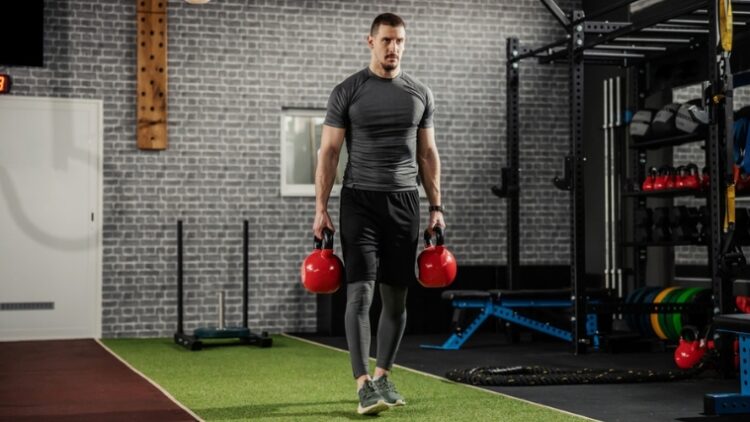
Two of the most common carrying events are the yoke walk and some type of front-loaded carry, be it with a sandbag or stone. However, the demands are mostly the same, no matter what you’re working with.
Benefits of the Loaded Carry
- Applies to nearly all aspects of strongman training and competition.
- A fantastic way to get some high-intensity cardio in.
- Easy to perform as long as you have enough space.
How to Do the Loaded Carry
How you hold onto the implement will be the deciding factor for any type of carry. If you’re working with a sandbag or stone, try to get your arms around or underneath it and hug it tightly to your torso. Leaning your torso backward as you walk may help offset some of the demands placed on your core.
If you’re walking with a frame on your back or weights in your hands, your focus should be on preventing any unwanted swinging as you take your steps. Keep your arms tucked to your sides and let them hang low.
As you walk, take short but rapid steps and focus on ground contact. Don’t march with your knees high; use the ground to your advantage for stability.
Loaded Carry Alternative
Walking with a heavy object (or two, depending on the event) is a strongman’s bread and butter. However, to do loaded carries, you need lots of space to move. This may not be practical, especially if you’re dipping your toes into strongman in a commercial gym.
In the event that you can’t do carries, you can sort of replicate the stimulus by working on your power shrugs or hitting the treadmill for some high-incline walks. The former focuses on explosive upper back strength and stamina, while the latter uses a graded surface to challenge your conditioning. Performing both, even if separately, can work in a pinch.
Axle Deadlift
Strongman training goes way beyond the traditional barbell. From extra-long bars to pulling full-sized truck tires to working with extra-thick steel logs, as a strongman trainee, you need to be comfortable working with nearly anything.
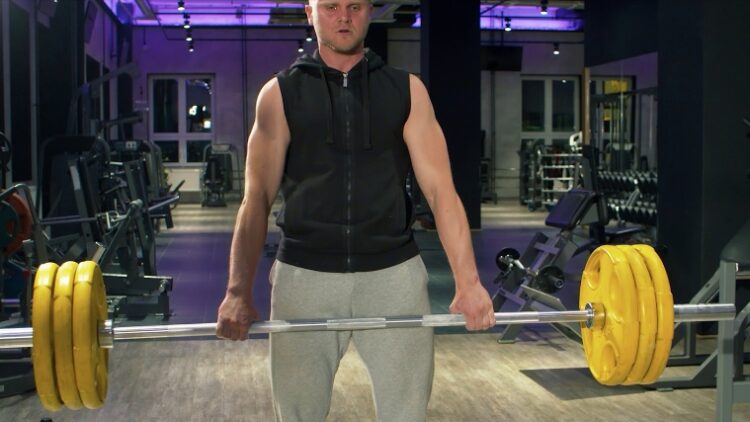
[Read More: The Best Upper Body Exercises and Workouts]
Hand-in-hand with a diverse assortment of bars comes the need to train your grip. The axle bar, which is notably thicker than the average barbell, is second-to-none in this arena.
Benefits of the Axle Deadlift
- Great for developing a strong grip.
- Carries over to many other strongman exercises or pieces of equipment.
How to Do the Axle Deadlift
You don’t necessarily need to adjust your deadlift technique to use an axle bar — the only thing you may have to change is your grip. The bar is too thick to use a hook grip and may be awkward to grab with a mixed hand position as well.
Assume a conventional deadlift stance with your feet under your hips. Hinge at the hips, push your butt back, and sink down until you can reach the bar. Wrap your hands around the axle snugly and use the bar to “pull” yourself into position. From here, deadlift as you normally would.
If you tend to break your pulls off the floor with an abrupt or jerky motion, you may struggle to work with the axle. You might lose your grip if you’re used to strapping up and ripping a standard bar off the ground. Take things nice and easy to begin with.
Axle Deadlift Alternative
Axle bars can be hard to come by and are almost nonexistent in most commercial gyms. They’re also expensive, so you may not leap at the chance to pick one up for your home gym. That said, solid grip strength is indispensable to the strongman.
Instead of gripping a thick bar, you can simply widen your hand placement and get a great workout along the way. The snatch-grip deadlift may be an Olympic lifting accessory, but it’s extremely hard to hold onto — hard enough that weightlifters rely on the hookgrip to get it done.
Avoid hooking your thumbs or using straps for this one. You’ll find that even a lightly-loaded barbell feels like many thousands of pounds if you grip it wide enough.
Sled Push
Strongmen push (and pull) just about anything you can think of during competitions, from loaded sleds to Mack trucks. Moving a large, heavy object through sheer force of will (and heaps of leg power) is integral to the sport — the sled push is a wonderful option here, and you can find it in most gyms these days.
Benefits of the Sled Push
- Works as both a conditioning tool and for developing strength.
- Easy to work with and doesn’t require a lot of technical practice.
- Closely mirrors the demands of competitive strongman training.
How to Do the Sled Push
You’ll need a weight sled and ample free space to push it. Load up the sled with some plates (start lighter than you think) and grab the handles. Tip over at the waist and spike one leg behind you as if you were about to sprint off the blocks at a track meet.
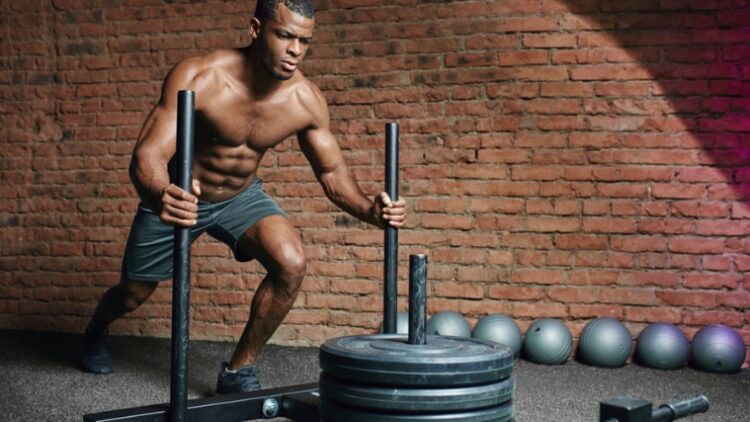
From here, drive your front foot into the ground to push the sled forward. Stay low and strive to maintain a straight line through your wrists, elbows, shoulders, and hips for the best leverage. Keep your arms locked and your shoulders packed down.
Sled Push Alternative
Strongman competitors have to be comfortable with moving weights across long distances. You can find a weight sled in most strongman gyms for exactly this purpose; it’s a second-to-none piece of equipment for loaded conditioning.
Sled work is also difficult to replicate if you lack the right implements. However, you may have some success if you really hammer a plyometric upper-body exercise like the clapping push-up.
This bodyweight movement demands robust upper-body explosiveness and will crank your heart rate up as well. If you have a weight vest and a high pain tolerance, you can get even closer to strongman-specific training by adding some resistance.
Sled Pull
On the other hand, sled pulls are just as valuable to the strongman as pushes are, and perhaps even moreso. If you want to eventually pull a small car in competition (or win every game of tug-of-war for the rest of your life), wrap a rope around a weight sled and get to work.
Benefits of the Sled Pull
- Great for strengthening your grip and upper back muscles.
- Works well as a conditioning tool at the end of your workout.
How to Do the Sled Pull
You’ll need a thick rope or cord to pull on the sled. Once you’ve fastened it around the sled, draw the rope out and grab the end with both hands. Sit down into a partial squat position and lean back slightly as you pull the sled toward you.
Sled Pull Alternative
Strongman events, despite how often you see athletes pushing or throwing, require extremely strong backs. This goes beyond being able to hang on to heavy deadlifts (though you’d better be a good puller if you want to compete in strongman).
https://youtube.com/watch?v=664VPfta8bA
Sled pulls torch your upper back and will get your heart rate up at the same time. If you don’t have a sled or the space to pull it, try the Kroc row instead. This single-arm row variation takes the reins off of maintaining airtight form. It’s more about how much effort you can put into moving a heavy weight.
Atlas Stone Lift
The Atlas stone may be the quintessential strongman implement. Its beauty lies in its simplicity, but that doesn’t mean lifting an Atlas is an easy task. There’s no handle to grab onto and no way to rely on lifting straps or other assistive equipment.
Benefits of the Atlas Stone Lift
- Engages almost every muscle in your body from head to toe.
- You’ll find a stone challenge in just about every strongman competition.
- Combines dynamic leg strength with upper-body endurance.
How to Do the Atlas Stone Lift
Make sure your hands are dry and chalked. Step up to the stone and bend over to get your arms around it. Think about wrapping your torso around the stone and try to get your hands as far around the object as possible.
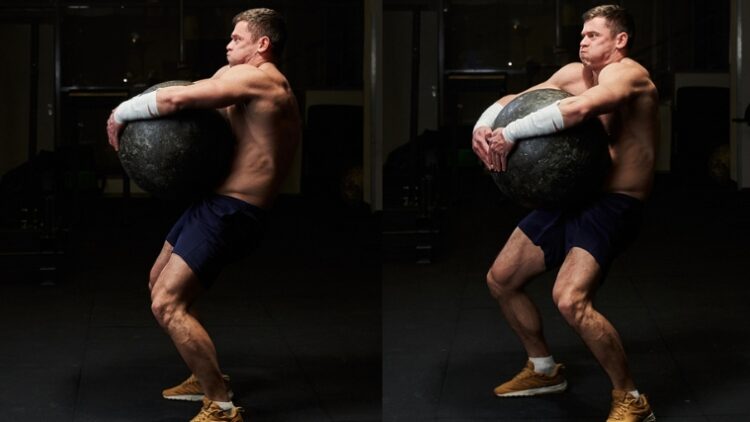
Once you’ve secured your grip and wedged yourself against the tone, pull with your back to get it off the ground. As soon as you feel you have enough height on it, drop into a low squat with the stone tight to your body. Allow it to rest on your legs to readjust your grip if needed. Then, stand upright, using your arms to hug the stone tight to your body the whole way.
Atlas Stone Lift Alternative
The mythical Atlas stones are as iconic to the sport of strongman as the barbell is to powerlifting or weightlifting. Unfortunately, you almost certainly won’t find any training (or practice) stones at your local globo gym.
You can, however, very closely replicate the challenge of hoisting a heavy stone by going old-school with the barbell — do the Zercher deadlift instead. The two movements are surprisingly similar in form and execution (at least until you stand upright). You can find a bar and some bumper plates just about anywhere, too.
Log Lift
You’ll generally see strongmen exhibit a lot of personality regarding how they approach the log lift. Some, like generational great Žydrūnas Savickas, lean heavily on efficient technique and athleticism, while others such as world-record-holder Iron Biby make it happen with unparalleled upper body strength.

No matter how you go about it, the log lift will challenge you in more ways than you might think.
Benefits of the Log Lift
- Offers a lot of freedom in how you approach the movement from a technical standpoint.
- Great for developing sheer upper-body strength.
- Tested at strongman competitions on a regular basis.
How to Do the Log Lift
Think of the log lift as a mix between a Zercher deadlift and a thruster. Address the log and grip the handles, then deadlift it. Once the log clears your knees, let it rest on your thighs as you sit down into a squat position.
From here, squat the log up and “roll” it up your torso until it rests on your shoulders. Drive the log overhead with a strict press, or dip your legs to perform a push press instead. Some strongmen competitors will even perform a power jerk to get the log up.
Log Lift Alternative
The log lift may be the single best expression of what it takes to be great in strongman. You need tremendous leg strength, coordination, pressing power, and above all, grit. Log bars aren’t easy to come by, though. So, what are you to do?
If your gym has a lifting platform and bumper plates, do the thruster instead. This weightlifting accessory exercise is, fundamentally, the same thing as the log lift; in one swift motion, get a bar from the floor to over your head.
The thruster takes a bit more technical precision, since you can’t really roll it up your torso or balance it on your knees. That said, the extra mobility work and dynamic movement that comes from working with the barbell will only be an asset when you finally get your hands on a log.
Kettlebell Swing
The kettlebell swing is one of the most versatile resistance training exercises out there. You can use it for general conditioning to maintain your health, as part of a leg workout to blow up your backside, or, ideally, as an accessory for strongman training.
Benefits of the Kettlebell Swing
- Effective as a teaching tool for producing power through hip extension.
- Relatively easy to learn and convenient to perform.
- Can be used for strength or conditioning.
How to Do the Kettlebell Swing
Take a semi-wide stance with a heavy kettlebell between your legs and slightly behind you on the floor. Hinge at the hips, bend down, and reach between your legs to grab the weight. You should feel your posterior chain tense up.

From here, thrust your hips forward and stand up to swing the weight forward. Lock and unlock your hips to generate some early momentum. Once the bell gets going, hinge at your hips quickly as it drifts backward between your legs, and thrust your glutes to propel it forward again.
Keep your arms tucked tightly to your sides the entire time. The kettlebell should only fly up to about the height of your belly button.
Kettlebell Swing Alternative
Strongman may not be a kettlebell sport, but damned if you don’t need explosive hips. The heavy kettlebell swing — Russian style, not American — is perhaps the best grab-and-go conditioning tool for any strength athlete.
Extra-heavy kettlebells are hard to find, though. You may not have access to sufficiently weighty ones in your gym. Adding in some extra deadlifts could work, but the best replacement may actually be the barbell hip thrust.
Thrusts aren’t just for growing your glutes (though they certainly work exceedingly well). Like kettlebell swings, hip thrusts dramatically reduce the amount of load applied to your lower back. If you want to practice for strongman but your posterior chain is pulverized, you can use thrusts as a workaround.
Tire Flip
Tire flips have fallen out of fashion somewhat in professional strongman, but you may encounter them from time to time in certain situations. As a training tool and when performed properly, they’re stellar for getting some high-intensity conditioning in.
Benefits of the Tire Flip
- A great way to “turn your brain off” and develop work capacity.
- Taxes your lower body, upper body, and grip all at once.
- Makes for a great partner workout if you each take turns flipping.
How to Do the Tire Flip
Approach a large tire and stand wide with your hands hanging straight downward. Sink into a sumo deadlift position by driving your knees out and dropping your hips until you can get your hands underneath the edge of the tire.
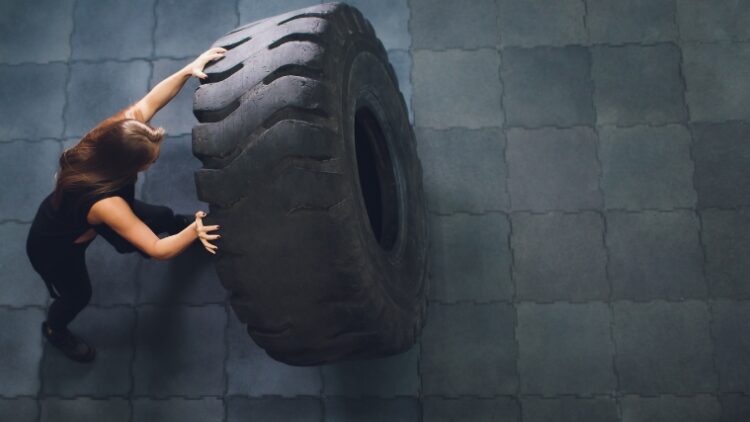
From here, initiate the lift by pushing into the ground with your legs and snapping your hips into extension. Shrug hard with your traps as well; the tire should elevate to around chest height. Then, rapidly flip your grip and “catch” the tire with your hands. Swap your feet to a staggered stance and push the tire over.
Tire Flip Alternative
You’ll see tire flips in strongman competitions from time to time, but they’re most regularly used as a training tool that closely mirrors an Atlas stone lift. Heavy tires make for a killer lower-body conditioning tool if you have access to them.
If not, you might want to borrow from the CrossFit camp and bang out some sumo deadlift high pulls instead. The fundamental idea is pretty similar; you have to transfer force from your hips up through your midline to elevate an object in front of you. Sumo deadlift high pulls are deceptively exhausting, too. Mind your breathing, or you might find yourself gassed out before you know it.
Front Squat
Strongman competitors spend a truly impressive amount of time carrying, throwing, or hoisting weights in front of them.
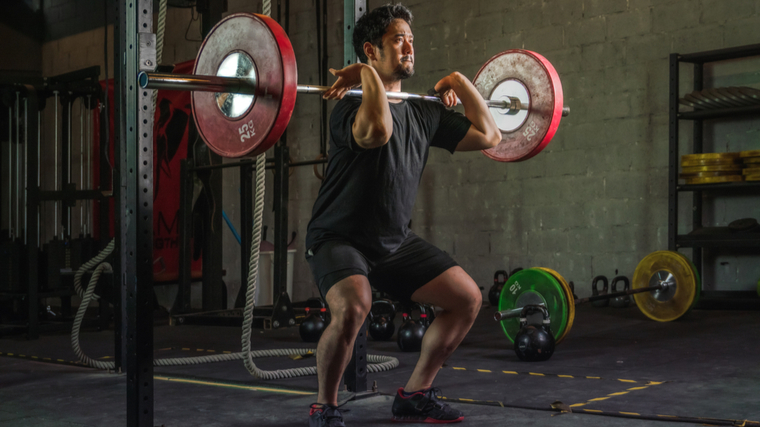
Anteriorly-loaded lower-body training is no walk in the park, so if you’re prepping to dive into strongman training, you need a squat variation that mimics the demands of your new sport. You need the front squat.
Benefits of the Front Squat
- Closely replicates the structural demands of many strongman movements.
- Easy to perform with just a barbell and doesn’t require any specialized equipment.
- Serves as a fantastic isometric core-trainer.
How to Do the Front Squat
Unrack a barbell from a clavicle-height rack in the front rack position; wrap your hands around the bar and flip your elbows forward. The bar should rest in the space between your collarbones and your front delts. Then, assume a comfortable squat stance and sink down into a deep squat. Fight hard to keep your arms up with your elbows pointed forward the whole way through.
Front Squat Alternative
Getting the front squat down pat requires more than a little upper back mobility and a great deal of wrist flexibility as well. If, for whatever reason, you can’t get your arms where they need to be, you can try the Zercher squat instead.
This variation is, for all intents and purposes, identical to the front squat. The only exception is that you don’t need to mobilize your upper back to the same degree. Zercher squats are, however, quite painful to carry in your elbows the first few times; but so are many strongman implements.
Find Your Power
From the outside, the sport of strongman may look like little more than a bunch of excessively-powerful athletes tossing around whatever odd items they can get their hands on (literally).
While that’s partly true, there’s a subtle elegance to the sport that you can’t really appreciate unless you dig into it yourself. If you have access to some strongman equipment or a specialty facility, it’s more than worth a shot. You’ll find strongman athletes to be welcoming and wholesome, and the work itself might teach you a thing or two about yourself as an athlete.
Featured Image: UfaBizPhoto / Shutterstock